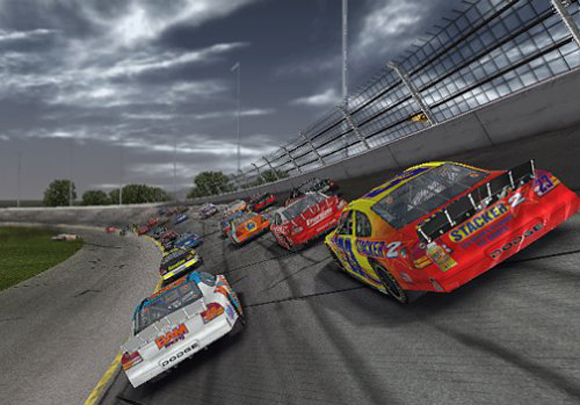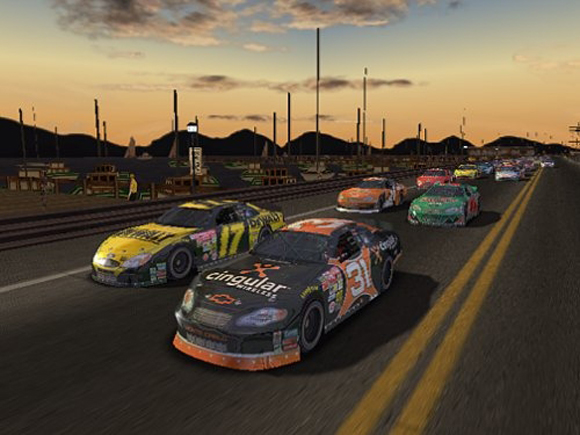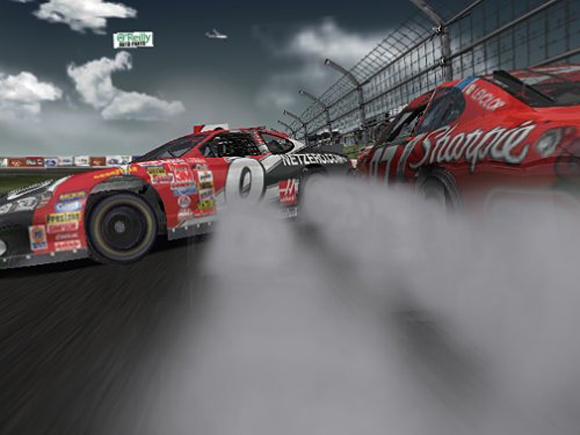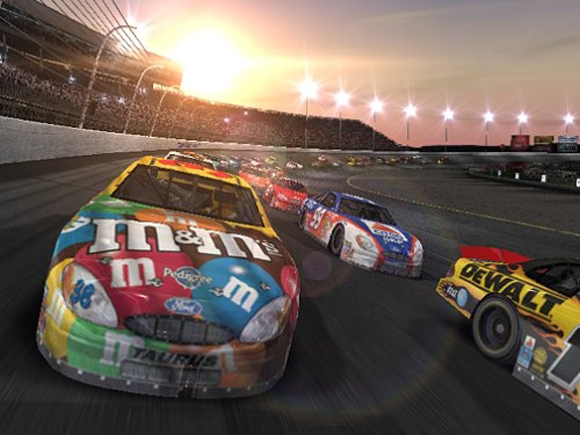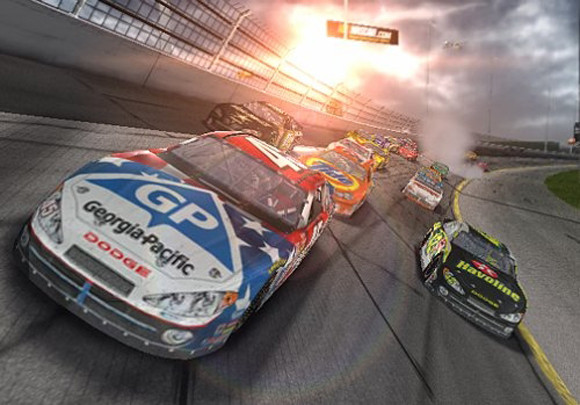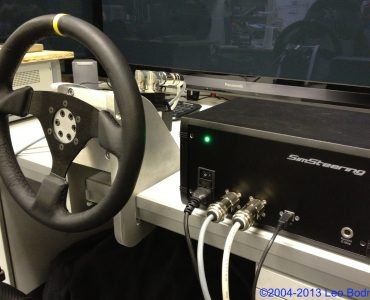Five days ago, a fellow VirtualR reader has kicked off a guest article column called the “B-List” where he visits past racing titles for the PC and gaming consoles, taking us down memory lane.
After the first edition covered NHRA 2007, he now takes a look at NASCAR Thunder 2004.
Do you like his column and would you like to read more? Leave him some feedback in the comment section below!
NASCAR Thunder 2004 (2003)
PS2 / XBOX
Tiburon Studios / EA Sports
It’s hard to imagine the pinnacle of stock car video games was reached a decade ago, and has been in a downward spiral ever since.
Ten years ago, we were signing crew chiefs, negotiating with sponsors for multi-million dollar contracts, developing track-specific engine configurations, banging fenders with drivers we’d wronged in previous races, and racing on the beaches of Daytona in one of the best racing games ever made for sixth-generation video game consoles.
Nowadays, the only good thing current NASCAR games are good for, are the trolling videos on YouTube, because God knows what happens when actually try to play the game.
Whatever your stance is on Eutechnyx, there is enough cold hard evidence to prove that twice in a row, for the Xbox 360 and Playstation 3, they’ve put out some of the buggiest and disappointing NASCAR games in history. And the voice of reason, the one that attempts to say: “remember when things weren’t this way!?” is silenced by obnoxious fanboys, power-tripping moderators, or even the lead developer himself.
The year was 2003, and the boys now behind iRacing had just released NASCAR Racing 2003 Season as their “final goodbye” after losing the exclusive NASCAR license to Electronic Arts. NR2003 was a landmark simulation that brought the raw experience of driving an eight hundred horsepower stock car to people’s home computers, albeit without fancy bells and whistles. While it was much more of a flight sim than Flight Simulator itself at the time, the game developed a massive following among PC oval racing enthusiasts, and is still played actively today.
However, for the console crowd, EA Sports had still yet to release their yearly NASCAR title. In press releases leading up to the day the game shipped, Electronic Arts had flat-out admitted that Papyrus probably had them beat. But, like a true fighter (and not the money-hungry overlord they’re recognized as today), EA also snuck in the ominous line “but we’ve got something up our sleeve, just wait and see…”
2003 ended up being a glorious year for NASCAR video game fans.
Defending cup champion Tony Stewart and Rob Zombie’s younger brother, Powerman 5000, greeted you upon the initial start-up, setting the atmosphere for another season of virtual NASCAR on your big screen TV. The “Press Start” screen featuring Stewart and then-DEI restrictor plate hero Michael Waltrip door slamming each other gave way to a slick menu with an insane amount of options and no clear-cut place to begin.
The tutorials, tucked neatly away in the menus under the “New” tag, brought you quickly up to speed with all of the new features without overwhelming you with information. This was, after all, EA’s third serious attempt at a NASCAR game, and the previous two games had been very well received, even by mainstream review sites that were only concerned about the next Tony Hawk or Madden release.
The big change for Thunder 2004 was the implementation of AI drivers who were not only fast and dynamic, but also cared about how you treated them. Give them room in corners or ride in their draft without forcing a pass, and they’ll gladly do the same for you as the race progresses. Nudge them out of the way or blatantly put them into the wall, and prepare for retaliation or even a season-long rivalry depending on the game mode. All of this was neatly presented to you through a redesigned heads up display, as well as the occasional comment from your spotter and crew chief over the radio.
At the time of release, this was seen as “over the top” by some in the budding sim community. Real-life NASCAR was still many years off from adopting the “boys have at it” mentality, and aside from the Kurt Busch / Jimmy Spencer saga that unfolded during the summer months of the 2003 Winston Cup season, on-track disputes were rare, unlike today.
As a result, this dynamic AI, who was now capable of having an opinion of you (both good and bad), made races exciting. Gone were the days of smashing the AI into the wall to win your fifteenth race of the season. At short tracks, you really would be rubbing fenders with everybody. At cookie cutter speedways, your “rivals” would attempt to block you or even dump you if you were in the lead. And at plate tracks, it was political warfare at two hundred miles per hour, with your friends poking holes in the pack for you to sneak through, and rivals running you all the way to the grass, simply unwilling to give up tenth place on lap five because you’d wrecked them three races ago.
It was nothing short of fantastic.
Not only because we’re talking about a racing series that features identically bodied cars on incredibly simplistic tracks, but because Thunder 2004’s physics weren’t nearly as demanding as the GPL-powered competitor on the PC, and an intelligent AI like that was necessary to keep people interested for more than a few laps. Cars were tail-happy but easy to catch from a slide. There were never any second thoughts about running the high line, regardless of what your setup suggested. Tracks that are known for being hell on the real cup drivers, such as Dover or Darlington, never required much attention to a particular line at all. Don’t lock the brakes up upon entry and you’re good to go.
Thankfully, to make things much more enjoyable for some of the more gifted virtual drivers among us, EA included “sliders” to adjust the difficulty beyond what the game shipped with. These “sliders” are quite common in other sports games such as Madden and NHL, allowing you to adjust all sorts of things such as aggression, quickness, chance of mistakes, and strategy.
For the casual NASCAR fan, there were many different game modes alongside your basic “quick race” option that were fun little diversions from the main game. “Thunder License” and “Speed Zone” were glorified driving school modes that taught you either the best driving line around all twenty three tracks on the Winston Cup schedule, or taught basic racecraft skill sets, long before racecraft was a common word in a sim racer’s vocabulary. “Lightning Challenge” featured bite-sized race scenarios from the past few seasons, such as making it through “The Big One” without damage at Daytona, or chasing down Ricky Craven as Kurt Busch, attempting to re-write history in the dramatic 2003 Carolina Dodge Dealer’s 400.
Completing all of these rewarded you with “Thunder Plates”, in-game collectibles that rewarded you with extra content. It was one of EA’s attempts to reach out directly to the console crowd, but some of the goodies were quite cool and useful. Many Cup drivers had a huge variety of alternate paint schemes locked away at the start, a handful of Busch drivers could be obtained from progressing through the “Lightning Challenge” mode, the original 1950 Daytona Beach road course, and who could forget the three mile, unrestricted Tiburon Speedway? It made progressing through the game fun, because you never really knew when the Pace Car would suddenly show up in the driver selection screen.
Truth be told, there was a lot to do outside of the game’s main mode of play, and while the actual driving wasn’t all that difficult, even with the assists off, the dynamic AI made things quite interesting.
But, just to let you know, you are a complete moron if you never had the attention span to give career mode a shot. You easily missed out on one of the best career modes in racing game history.
Months before NASCAR The Game: Inside Line was released; the developers actively took to the forums and asked what people wanted to see out of career mode in the new title. The consensus was astonishingly simple, yet so incredibly specific at the same time: “Make it like NASCAR Thunder 2004.”
The ability to buy three different engine upgrades was not what we meant.
You start career mode as low on the totem pole as you can possibly be, with a car that might as well have been made of MegaBlocks. K-Mart, of all companies, have decided to give you just enough money to get to Daytona, and your crew members most likely graduated high school a few years later than they should have. Unless you’re a cheating loser who googled “perfect setups for NASCAR Thunder 2004”, you’ll get your ass handed to you weekly.
But that prize money for last place, over time, is just enough to get you going, provided you know where to spend it. And the simplistic career mode menu hides many different places to spend cash, all of which have a direct effect on the performance of you car.
Before you know it, you’re allowing your semi-retarded engine designer to use one million of your start-and-park dollars to design an engine that outputs five more horsepower than your current engine. Or you’re taking advantage of an off-week to repair your primary chassis after weeks of moderate abuse.
The K-Mart contract runs out, and you replace them with Nikon cameras, a company that pays you slightly more adequately, and you’re so damn excited about the prospect of being able to afford a chassis development center in ten seasons that you completely change your paint scheme, and switch from Chevrolet to Dodge.
The powerplant developed by your engineer who still writes his “c’s” backwards and wakes up early to watch Spongebob on Saturday mornings now managed to get you up to semi-competitive speeds. That, and some wishful thinking in the setup department landed you on pole for the first Michigan race by some act of God. You drive your ass off, your pit crew forgets to imitate The Three Stooges during your pitstop and actually does their job, and you find yourself shocked to be in victory lane.
This is how everyone’s first season in career mode goes. But once the success comes, the game opens up immensely.
Kyle Petty retires at the end of the first season and gets replaced by an up-and-coming Busch series driver, usually Brian Vickers or Ron Hornaday. Your late-season surge up through the standings has landed you some decent cash, and you’ve significantly upgraded your race shop, installing a wind tunnel and some sort of computer equipment that makes developing new chassis take significantly less time. You fired most of your old pit crew, crew chiefs, and engineers, in favor of more competent people who can build you track-specific engines and chassis, although you didn’t have the heart to tell them you can’t afford to do that yet. You change your entire paint scheme and switch to a Pontiac for Speedweeks, attempting to re-write history, starting a weekend earlier than most teams with “The Shootout.”
This is not just creative writing; this is the kind of adventure everyone goes on while playing NASCAR Thunder 2004’s career mode.
You can hire and fire you entire race team, either as a group, or individually if you want to hurt someone’s feelings. Drivers retire or swap rides at the end of each season. You can build engines, chassis, shop additions, or dedicate your team’s time to researching and developing new parts, which do have a tangible effect on the performance of your car, and the quality of which depends on the skill of your engineers. A multitude of sponsors come and go, each offering various amounts of money and goals for you to accomplish, and occasionally, if you’re in the right place at the right time, you’ll be able to take over for a driver who retired at the end of the previous season. Rookie stripes disappear after every driver’s first season, prize money is given out for gaining the most spots or having the fastest lap, and every single non-points event is included, complete with proper entry requirements and format.
This is on top of the lengthy pre-race intros that feature anthems, fighter-jet flybys (with various different types of airplanes), driver intros, pace laps, and two distinct commentary teams to simulate the FOX / NBC change that occurs at mid-season.
In the newest NASCAR game, we can buy three different engine upgrades in Career mode. The vast majority of forum users unanimously praised the game; some even called it the best NASCAR game ever, even while YouTube video after YouTube video was posted, completely destroying any outside credibility the young Eutechnyx series once had.
Apparently, nobody seems to realize that things have been moving in the wrong direction.
With how shoddy and disappointing the past two Eutechnyx NASCAR titles have been, there’s no way you shouldn’t still be playing NASCAR Thunder 2004. Period.
But yet, people are quick to completely rule out a game from ten years ago because it isn’t for the latest & greatest gaming console, and they will happily convince themselves that a broken online component and embarrassing AI is perfectly okay for a racing title in 2013, just because they want to drive as Brad Keselowski.
So, the next time you’re at GAME, or GameStop, or EBGames, go look in the old PS2 / XBOX game section and buy NASCAR Thunder 2004 for a whopping two dollars. Pretend it’s like downloading a historic carset for one of your favorite racing sims. That’s what I do.



